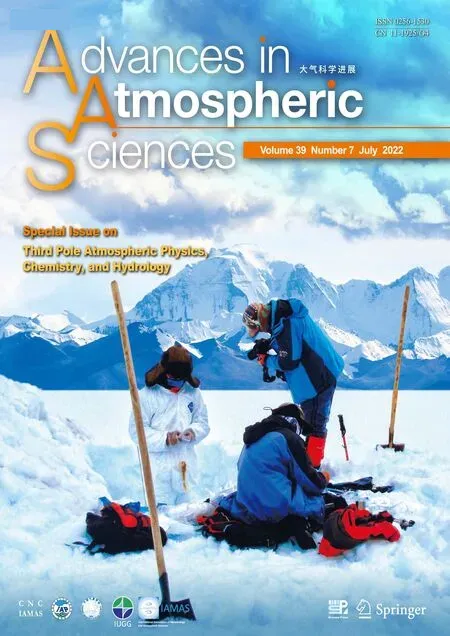Electronic Supplementary Material to:Influence of South Asian Biomass Burning on Ozone and Aerosol Concentrations Over the Tibetan Plateau*
Junhua YANG ,Shichang KANG*,2,3 ,Yuling HU ,Xintong CHEN,2 ,and Mukesh RAI,2
1State Key Laboratory of Cryospheric Science, Northwest Institute of Eco-Environment and Resources,Chinese Academy of Sciences (CAS), Lanzhou 730000, China
2University of Chinese Academy of Sciences, Beijing 100049, China
3CAS Center for Excellence in Tibetan Plateau Earth Sciences, Beijing 100101, China

Table S1.The detailed information of the monitoring sites over South Asia.

Fig.S4.Seasonal variation trend of precipitation from the CRU dataset.

Fig.S5.Annual emissions of CO in the pre-monsoon.

Fig.S6.WRF-Chem simulated surface wind during different seasons.

Fig.S7.Seasonal variation of residential emissions of SO2 (the left row) and NOx (the right row).

Fig.S8.Deviation of pre-monsoon (the left row) and winter (the right row) secondary PM2.5 components from annual average,as calculated by (M -N)/N,where M and N were pre-monsoon (winter) and annual concentrations respectively.

Fig.S9.Deviation of pre-monsoon (the left row) and winter (the right row) primary PM2.5 components from annual average.

Fig.S10.O3 precursors (ppb) change due to South Asian biomass burning during pre-monsoon.

Fig.S11.Horizontal and vertical transport of black carbon (BC,μg/m3) and organic carbon (OC,μg/m3) from South Asian biomass burning to the TP.

Fig.S12.Aerosol precursors (ppb) change due to South Asian biomass burning during pre-monsoon.

Fig.S13.The contribution ratios (%) of South Asian biomass burning to NO2.

Fig.S14.Winter residential (a) and industrial (b) emissions of PM2.5.
 Advances in Atmospheric Sciences2022年7期
Advances in Atmospheric Sciences2022年7期
- Advances in Atmospheric Sciences的其它文章
- Understanding Third Pole Atmospheric Dynamics and Land Surface Processes and Their Associations with the Cryosphere,Air Quality,and Climate Change※
——Preface to the Special Issue on Third Pole Atmospheric Physics,Chemistry,and Hydrology - Electronic Supplementary Material to:Impacts of Topographic Complexity on Modeling Moisture Transport and Precipitation over the Tibetan Plateau in Summer*
- Electronic Supplementary Material to:Improving Simulations of Vegetation Dynamics over the Tibetan Plateau:Role of Atmospheric Forcing Data and Spatial Resolution*
- Electronic Supplementary Material to:The Warming of the Tibetan Plateau in Response to Transient and Stabilized 2.0°C/1.5°C Global Warming Targets*
- The Warming of the Tibetan Plateau in Response to Transient and Stabilized 2.0°C/1.5°C Global Warming Targets※
- Influence of South Asian Biomass Burning on Ozone and Aerosol Concentrations Over the Tibetan Plateau※
